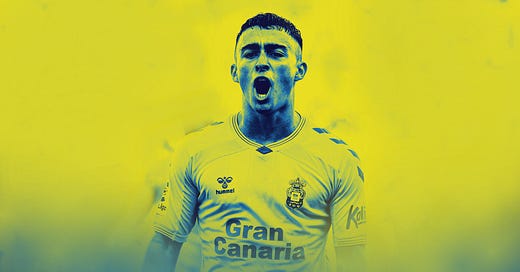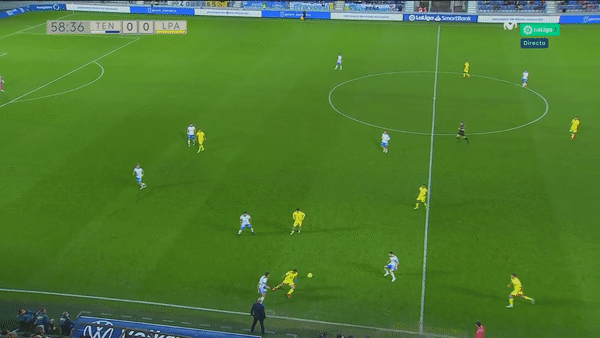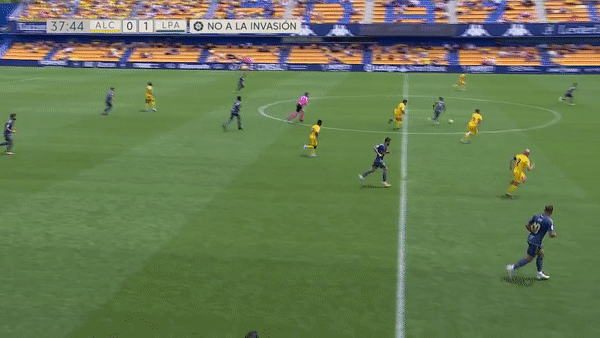On the Radar: Alberto Moleiro
Following on from the Pedri deal of 2019, Barcelona are one of a number of teams hunting the Canary Islands' latest star arrival.
The diminutive midfielder, the surprise pre-season addition to the first team squad, the teenager who scaled the ranks over in Las Palmas despite being from Tenerife, and the one who showed enough in his first season at senior level to direct Barcelona’s attention to the second division. No, not Pedri.
Alberto Moleiro.
Admittedly, the parallels are pretty strange if this deal is to go through — especially just a few years apart. But while the sequence of events might be rather peculiar, it’s all very logical at the same time that Barcelona should return to fish in the waters of Las Palmas so quickly.
Beyond their own talent factory at La Masia, the Canary Islands have a football identity in which Barcelona will see, if not some of themselves, something which resonates with them strongly. For example, it was no coincidence that in January, Las Palmas made the difficult decision to part with their manager Pepe Mel and replace him with García Pimienta — the coach whose reputation had been built entirely within the system at La Masia since the early 2000s, and whose last job had been in charge of Barcelona B.
It was a mutual understanding on both parts. Las Palmas wanted to reinforce an attractive, attacking style of play in line with their personnel (in order to try salvage a play-off spot, which they did), as well as satisfy the unwritten rule that a manager of the club should ideally share the same philosophy. The Estadio Gran Canaria is not a place where fans pay to see the pursuit of results by any means.
On the other side of the negotiation, García Pimienta’s education in the Barcelona model would be as valuable in Las Palmas as perhaps anywhere else in Spain. There would be no opposition to a Cruyffian design of doing things. When asked about the 4-3-3 framework and his ideas from Barcelona upon taking over, Pimienta replied: “(Las Palmas) resemble that idea of play a lot. I don’t think we’re going to have much difference here.”
The environment is as it is precisely for the types of players that traditionally emerge from the Canary Islands. If one were to create a best XI from the region over the last 30 years or so, it would be an incredibly top-heavy side, dominated by players who shine with the ball at their feet. Technical quality and a confidence to play is an almost universal quality in their best talent.
Former manager Quique Setién, who — incidentally — Barcelona would later hire after his impressive work in Las Palmas, put his success on the island down to re-connecting the players with the ball. The most distinctive look of his team had been a midfield three of Roque Mesa, Jonathan Viera and Tana; three players all from the island of Gran Canaria, who collectively had an average height of 5’7. They may have been almost comically diminutive, but they shared a football language.
And so it isn’t the first time, nor will it be the last, that Barcelona come knocking.
“These players are a reflection of what I was in the schoolyard. In Las Palmas, they still play a lot of football in the street. I go to walk my dog and I stop near the small pitch near where I live. I watch the kids play there, how they play with such personality, and they are players who never knock the ball above head height. It’s in their blood.”
Quique Setién, Onda Cero (2016)
Is Alberto Moleiro really the ‘new Pedri’?
From his starting position on the left side of Las Palmas’ front three (in a 4-3-3), Moleiro became an integral piece down the stretch of the season for his comfortability playing inside and outside. In a season which began with a surprise promotion, the 18-year-old gradually went from impact sub to an indispensible piece, culminating in a fine end to the campaign where his influence grew by the week.
García Pimienta could count on Moleiro in three main ways: to figure as an orthodox winger (predominantly on the left), to come inside off the wing and open space for full back Sergi Cardona, and to intermittently swap positions with Jonathan Viera as Las Palmas’ interior on the left side. In the last few months of the season, he became a key ingredient in developing the fluidity of play that Las Palmas were searching for.
The most striking part of Moleiro’s game — and the thing that produces his versatility in possession — is the way he manipulates the ball across the range of situations that modern football presents. If there’s one thing he certainly shares with Pedri, it’s the ability to play in areas where space isn’t abundant. Receiving passes in tight windows and finding his way out of them is Moleiro’s signature play.
Of course, playing effectively in reduced space isn’t always achieved in exactly the same way. Where Pedri was (and is) a more positional player who relies on timing and managing the distance between him and defenders with such precision, Moleiro’s particular strengths come through his lower centre of gravity and agility to escape shrinking spaces. Pedri plays with a more unhurried style, while Moleiro is swifter from first control into his next movement. It’s in that small detail where a more general separation can be made between the two: the Barcelona midfielder is a conductor of play, and Moleiro — for now — is more of an inventor, who intervenes closer to goal.
From a statistical perspective, the Santa Cruz native isn’t the owner of numbers that jump off the screen. He averaged roughly one shot assist per 90 in Segunda last season and only directly contributed to four goals in just over 2,000 minutes. The salient point is that a single season between the age of 17 and 18 isn’t a big enough pool to draw meaningful conclusions through data — the eye test, meanwhile, has been a unanimous success. There’s a reason why top teams from Spain, England and Germany were climbing over each other to try and sign him, and it’s not because of the numbers.
An important thing to note in view of Moleiro’s individual season is that he played in a team with Jonathan Viera. Las Palmas’ captain is the consensus top player in Segunda, and accounted for almost a third of the team’s assisted shots when he was on the pitch — the biggest share of any player in the league. Think late stage Lionel Messi at Barcelona, where nearly every attack centres around a single player, just on a smaller scale. The rest of the team played off the positioning of Viera, who owned the creative monopoly of the team.
In the clip below, note how quick Moleiro is to look back in Viera’s direction after they neatly escaped Tenerife’s pressure. Las Palmas deferred to him constantly.
Where Moleiro did stand out relative to his peers, however, was in his ball retention. The 18-year-old is an economical player who excels in giving continuity to spells of play — precisely what García Pimienta was looking for. Moleiro completed 86 percent of his passes in the opposition half last season, which was the highest rate of any attacking midfielder or winger in the league. Similarly, his possession loss rate of 24 percent was the seventh-lowest within the same positional group.
Of course, the types of distribution and style of play have a large say in completion rate. In Moleiro’s case, it was often about trying to shift the opposition by moving the ball accurately in the final third, and avoiding low-quality balls into the box. His qualities were best applied for ensuring Las Palmas’ attacks didn’t break down; instead, maintaining their rhythm of play against defensive units who were, predominantly, focused on protecting their half. One-two’s, sharp combinations and consistently good protection of the ball is his bread and butter.
Among the reasons that Moleiro hasn’t played as a true interior for Las Palmas, despite his technical ability in central areas, is the simple fact that he can do a lot of things like an orthodox winger. With him, García Pimienta could have the best of both: a player who could occupy the wing and figure as an extra midfielder in a high-possession team.
Although he’s a naturally associative player, the teenager isn’t hesitant to face his defender up. From there, Moleiro really channels his low centre of gravity through feints and sharp changes of direction. Those are usually enough to earn him some daylight, and he’s tough to bring back in a foot race once he’s stolen a march.
In these positions we see another divergence for Moleiro in comparisons with Pedri. He’s a more direct dribbler when presented with one-v-one situations, and has much quicker foot speed to be able to change direction when driving forwards. Add that to his smaller stature and Moleiro is a nightmare for defenders trying to maintain their balance and stay in front of him.
Indeed, to compare their numbers for take-on attempts, Moleiro (5.4) averaged two more than Pedri (3.4) on a per 90 basis in their respective Segunda seasons. Along with the higher frequency, Moleiro was much more active with take-on attempts in wider areas, which highlights his more direct style as a ball carrier. In-keeping with the player projections, if Pedri figures to be the closest thing to Andrés Iniesta, then Moleiro has a touch of Lorenzo Insigne within a game that is otherwise highly suited to central areas.
In the long-term, Moleiro clearly projects as more of a creative player than a goal threat. He scored three times last season from an xG of almost exactly three, and took 52 percent of his shots from outside the box. On a more stylistic note, however, Moleiro showed some positive signs in terms of his ball-striking ability. His small stature isn’t an impediment to producing clean strikes, and along with the Insigne comparison in terms of style, has a good eye for opening windows to shoot.
This effort against Ibiza didn’t find the net, but the quick shift and well-hit strike in the same movement was a good display of his technique:
Overall, the central attraction of Moleiro is that, at just 18 years old, nobody can say with any certainty which position he will make his name in. His attributes lend him to practically every attacking role besides that of a centre forward, and in time, there’s little doubting that he has the combination of intelligence and technical skills to play as a central midfielder. Much like the Pedri of today, the beauty will be in the eye of the beholder.
Repeating Pedri’s trajectory beyond Las Palmas will be practically impossible — the Barcelona midfielder has had one of the most dramatic rises you will ever see in football, aided by talent, a remarkable maturity and the circumstances of opportunity. Pedri’s season at Las Palmas is also a clear reminder that the first view of a player isn’t necessarily what the recruiting club have in mind. In 2019-20, Pedri played largely in a wide position — much like Moleiro in 2021-22 — yet was Barcelona and Spain’s most important interior by the time EURO 2020 ended.
Although both players were first accomodated at senior level in wider starting positions — mainly for the fact of allowing more expression of play, as well as that teenage midfielders are usually kept out of central midfield for physical reasons — the clues of their compatibility across a wide range of midfield roles were left all over their individual Segunda seasons.
For Moleiro, his comfortability in playing a 360-degree game is quite remarkable for his age and existing experience. The ease with which he can look like a central midfielder and a true final third player within the same sequence is, in a snapshot, exactly why clubs from around Europe had been so keen to recruit him. Whether it is Barcelona, Manchester City, Villarreal or Eintracht Frankfurt — just a handful of the clubs that had been tracking him — Moleiro’s attributes can be honed in so many ways by their different interpretations and contexts of style.
The giants of European football are looking for ingredients in young players; those that can be applied to the way those teams aim to play the game, as well as the direction in which football at their level is heading on a larger scale. And Moleiro is precisely the on-ball talent that can be moulded to meet the future.













